|
[Front Page] [Features] [Departments] [Society Home] [Subscribe]

Starting Out with Native Orchids
Brian Walters
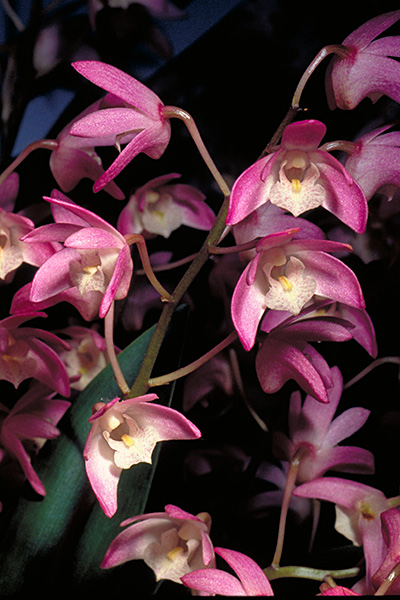 |
|
| Dendrobium 'Bardo Rose' |
|
Look...! I'll just have to "come clean" right at the start.
When it comes to orchids, I am the proverbial klutz. A dolt! An orchadian illiterate!
"Stick to what you know", has been my policy. "Readers will know when you're bullsh.... er, attempting to spread bovine manure in liberal quantities".
So what has possessed me to advise readers on the cultivation of native orchids?
Well, this is about "Starting Out". And in that area I am, in all modesty, reasonably competent!
You see, it's a bit like those who claim that it's easy to stop smoking because they have done it so often! I have started growing native orchids so many times that I have accumulated extensive expertise in that area. Progressing further? Well, that's an entirely different matter!
If nothing else, though, my mistreated collection has shown pretty clearly how easy it is to grow native orchids provided, of course, that you choose your first specimens wisely. My own experience is that some are virtually unkillable. Which is just as well.....
Species and Hybrids
Orchid growing has become such a specialised field and has accumulated so much mythology that the uninitiated could be excused for thinking that they are some extraterrestrial life form.
| |
What's a Dockrillia? |
| |
Although the name Dockrillia was established as far back as 1981, it is only in recent years that the name has been resurrected. The genus Dockrillia has been split off from Dendrobium and comprises the "terete-leaved" group of "dendrobes". This revision has been generally accepted in Australia.
Species in Dockrillia are characterised by succulent leaves which are rounded in cross-section (terete) and which arise from a creeping rhizome. Currently about 28 species are recognised.
Dockrillia is named after Alick Dockrill. |
| |
 |
| |
The well known "tongue orchid", Dockrillia linguiformis was previously known as Dendrobium linguiforme.
Select the thumbnail image or plant name for a higher resolution image [28k] |
So, the first step is to ignore the jargon and accept that they are just plants. They have certain specific needs but so do grevilleas, azaleas, ferns or any other group of plants in cultivation.
There are two basic groups; terrestrial and epiphytic. Yes, yes, I know that's a fairly simplistic classification, but we're beginners, OK?
Terrestrials grow directly in soil like most of the plants in our gardens. Epiphytes grow mainly on trees or rocks, although the latter are more correctly called "lithophytes". Epiphytes aren't parasites, however. Unlike mistletoes they use a host tree simply as a means of support.
Many natural hybrids between orchid species occur both in Australia and overseas. But in hybridisation, nature is no match for the enthusiastic orchid grower. Among the exotic orchids there are literally thousands of registered hybrids, many being complex crosses between different genera or between previously developed hybrids.
Basically, native orchid cultivation (certainly as far as the beginner is concerned) is, almost exclusively, the cultivation of the epiphytic species and hybrids in the genera Dendrobium and Dockrillia. And it's those two that are the focus here.
There are about 50 native Dendrobium/Dockrillia species occurring mainly along the east coast. As might be expected, tropical species require a heated glasshouse in the southern states while species from New South Wales and Victoria do not perform well in north Queensland.
Registered hybrids based on Australian dendrobiums now number well in excess of 100. One aim of current hybridisation work is to combine the features of the warm and cool growing species.
Growing Mediums
The important factor for all epiphytes is that the growing medium must be very open allowing free drainage. Standard potting mixes are not suitable for these plants. Many beginners have difficulty in accepting that plants can grow in a medium comprising nothing more than pine bark chips. This works quite well with dendrobiums but other coarse materials such as gravel or charcoal are used successfully.
Vigorous species can also be attached to trees (preferably types that don't lose their bark) or rocks. The plant needs to be tied tightly so that it does not move in windy conditions. Eventually the roots will take a firm grip on the host and the tying material can be removed.
The less vigorous epiphytes are often tied to slabs of cork or tree fern and hung in a bush house.
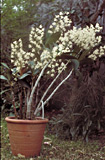 |
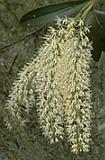 |
|
Two popular dendrobiums for the beginner: D. x 'delicatum' (left) and D.speciosum.
Select a thumbnail image or highlighted name for a higher resolution image [44k and 37k]
|
Feeding and Watering
Entire books have been written on the subject of orchid cultivation and enthusiasts usually develop their own favourite methods, often varying the procedures between species. So, am I going to attempt to outline cultivation techniques in a couple of paragraphs?...You bet!
My plants receive a light dressing of general slow release fertilizer whenever I repot and I try to remember to give them another dose after flowering. This works OK but I can already see the purists throwing up their hands in horror!
The plants are watered whenever the other plants in my "nursery" are watered which is daily in summer decreasing to 2-3 times a week in the depths of winter. This is more or less in agreement with the usual advice that water should be restricted in the cooler months to give the plants a rest and prepare them for flowering. The experts tell me that they would cut the water down to once every one to two weeks in winter....oh, well.
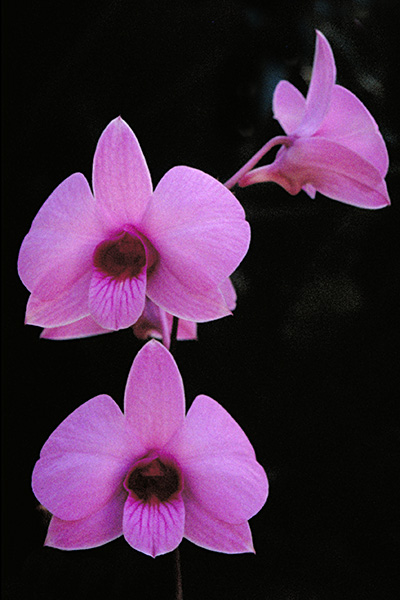 |
| The Cooktown Orchid, Dendrobium biggibum |
Selection
Selecting suitable plants for a first collection will obviously depend on where they are going to be grown. The following have a wide natural range and should perform well outdoors (or in a bush house under about 50% shade) in both temperate and tropical areas. However, growers in the tropics should avoid forms native to southern areas and vice versa.
- Dendrobium speciosum...a magnificent species generally called the "Rock Orchid" or "Rock Lily" but some forms grow on trees. It can form large clumps over 2 metres in diameter if left to its own devices. White to pale yellow flowers occur on long racemes which may each contain over 100 individual blooms.
- Dendrobium gracilicaule...a species with slender stems and yellow flowers generally with reddish blotches. This plant can be grown in a pot or attached to slabs of cork or wood.
- Dockrillia linguiformis (formerly Dendrobium linguiforme)...a distinctive species with thick, fleshy leaves which give rise to the common name of "Tongue Orchid". It is best grown on a cork or wood slab as its growth habit is not suited to pots. Flowers are white to cream.
- Dockrillia teretifolia (formerly Dendrobium teretifolium)...this is a pendulous species with long, thick leaves which are round in cross section. The plant has white flowers and is best suited to growing on a slab.
In temperate districts, the following are found in the collections of most enthusiasts:
- Dendrobium kingianum...a very well-known species. Considerable work has been carried out to produce improved colour forms. It is easily contained in fairly small pots. Flower colour varies from white to purple.
- Dendrobium x delicatum...a natural hybrid between D.speciosum and D.kingianum. Because of the variability of its parents, it too is quite variable but generally very rewarding. Flowers can vary from white to pink and are sometimes perfumed.
- Dendrobium falcorostrum...the "Beech Orchid", so named because it grows in native beech forests of NSW and southern Queensland. This is a particularly beautiful species with waxy, white flowers. Best in cooler areas.
In the tropics no collection would be complete without the magnificent "Cooktown Orchid", Dendrobium bigibbum. It may even be grown outdoors with care in southern coastal Queensland - further south a glasshouse is needed. The large purple blooms of this plant have made it Australia's best known orchid and Queensland's floral emblem.
Selection of hybrids can be a little frustrating for the beginner as quality, flowering size divisions are not readily available. Hybrid seedlings, usually in 50 mm tubes, are easier to obtain. However, these are "un-flowered" crosses and there can be a degree of "pot luck" involved due to genetic variation inherent in seedlings. Generally growers will be only too pleased to advise on the expected flowering characteristics of a hybrid seedling. It's also advisable to note the parentage of any hybrid that appeals to you. Then if you come across a seedling with the same parents, it will probably be worth a try. Several attractive hybrids are shown in the accompanying photographs.
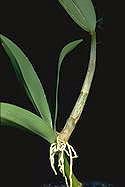 | 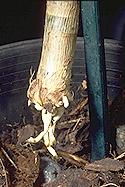 |
 |
| An aerial growth ("keikei"), with some roots attached (top left), is secured to a small stake in a pot (top right) and backfilled firmly with pine chips. |
| |
Propagating
For the beginner, propagation of Dendrobium/Dockrillia involves either dividing the clumps or removing (and potting up) the aerial growths that occur on some species and hybrids of Dendrobium
Division of large clumps is fairly straightforward; you simply remove the plant from the pot (often this may mean destroying the pot!) and cut the clump into segments each comprising about 4-5 stems.
The propagation of aerial growths (called "keikeis") is also quite simple. The aerial growth is removed from the parent plant and placed in a small pot of pine bark or other medium so that the level of the medium just covers the roots of the small plant. It's a good idea to support the small plant with a short stake until the roots have become firmly established, as shown in the photographs at right. Place the pot in a protected position and water occasionally.
Getting Serious!
So now you know how to "get started", but where do you learn more once the bug has bitten?
For the native orchid enthusiast, there is no better source of information than the Australasian Native Orchid Society (which goes by the unfortunate acronym of "ANOS"). This organisation caters for all levels of expertise and publishes an excellent quarterly journal, "The Orchadian". There are district groups in many parts of Australia. Further information can be found on ANOS' website.

[Front Page] [Features] [Departments] [Society Home] [Subscribe]
Australian Plants online - September 2001
Association of Societies for Growing Australian Plants
|